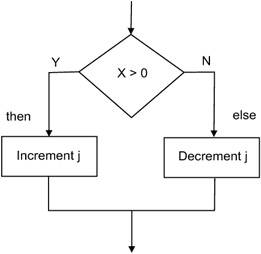7.2 Selection Structure
7.2 Selection Structure
As mentioned earlier, the selection design structure is also called alternation, because alternate paths are considered based on a condition. This design structure is easier to understand in a flowchart. Figure 7.1 shows two possible paths for the execution flow. The condition is examined (or evaluated), and a decision is made to select one of the paths. If the condition is true, then the left path is taken and the instructions on this path (Block1) are executed. If the condition is not true, then the other path is taken and the instructions on this path (Block2) are executed. Thus, the selection structure provides the algorithm capability for decision-making.

Figure 7.1: Flowchart segment general selection structure.
7.2.1 Pseudo-Code and the IF Statement
In the pseudo-code notation, the selection structure is written with an if statement, also called an if-then-else statement. This statement includes several keywords; recall that these are reserved words because the programmer cannot use any of these words for other purposes. The keywords are: if, then, else, and endif.
The informal pseudo-code for the if statement that corresponds to the general selection structure illustrated in Figure 7.1 is:
if condition is true then perform instructions in Block1 else perform instructions in Block2 endif
In KJP, the general structure of the if statement is:
if 〈 condition 〉 then 〈 statements in Block1 〉 else 〈 statements in Block2 〉 endif
Note that the keywords used in the pseudo-code are written in bold to clarify their usage. The if statement is considered a compound statement.
| Note | All the instructions in Block1 are said to be in the then section of the if statement. In a similar manner, all the instructions in Block2 are said to be in the else section of the if statement. |
When the if statement executes, the condition is evaluated and only one of the two alternatives will be carried out: the one with the statements in Block1 or the one with the statements in Block2.
7.2.2 Conditions and Operators
The condition consists of an expression that evaluates to a truth-value, true or false. These types of expressions are also known as Boolean expressions. A simple Boolean expression compares the value of two data items.
A simple Boolean expression is composed of two data items and a relational operator to compare the two data items. There are six relational operators:
-
Equal, ==
-
Not equal, !=
-
Less than, <
-
Less or equal to, <=
-
Greater than, >
-
Greater or equal to, >=
Examples of simple conditions that can be expressed with the relational operators in KJP are:
x >= y time ! = start_t
| Note | Instead of applying the mathematical symbols shown previously for the relational operators, additional keywords can be used for the operators in KJP. For example:
x greater or equal to y time not equal start_t a greater than b |
7.2.3 A Simple Example of Selection
As a more concrete example, consider a portion of an algorithm in which the decision whether variable j should be incremented or decremented depends on the condition: x > 0. Figure 7.2 illustrates the flowchart portion of the algorithm that includes this selection structure for this simple example.

Figure 7.2: Example of selection structure.
For this example, the portion of the algorithm written in pseudo-code is:
if x > 0 then increment j else decrement j endif
In the selection statement, only one of the two paths will be taken; this means that in the example, the statement increment j or the statement decrement j will be executed. This depends on the evaluation of the condition x > 0.
EAN: 2147483647
Pages: 184